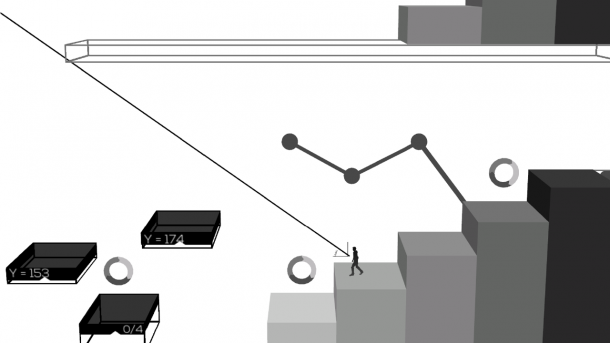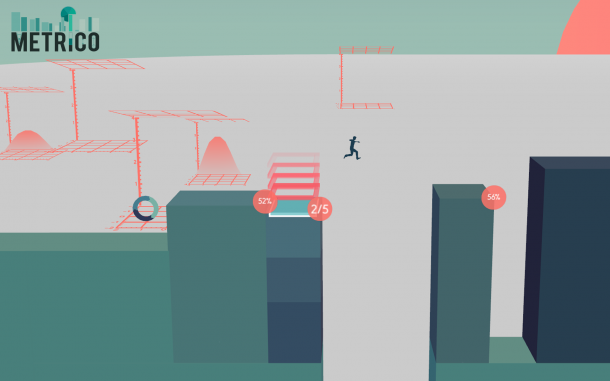Powerpoint can be very pretty. I’ve spent countless hours in the tool, creating presentations to CEOs and managers on an almost weekly basis. When trying to tell a story about data, being visual is one of the most important elements and can add appeal to an otherwise mundane subject.
Game developer Digital Dreams is taking a similar approach with its newest outing, Metrico, for the PS Vita.

Billed as the first “infographic” video game, Metrico uses data within it to generate its 2D world and allow us to solve its puzzles. At first glance this is heavily centered on its visual delivery of the concept. In fact, the simple design is elegant in execution. The landscapes and animations look and feel like someone has been playing in Adobe Illustrator all afternoon, with a definite flat design. Each level has a visual theme, whether it’s black & white line drawings or cascading gradients of color. The overworld is even designed to look like a modern subway map.
It’s definitely pretty.
The data aspect is interesting, too. It, and the art style, are integrated. Numbers and signs pop up through the levels, letting us know that we’ve added to some growing datum as we jump or solve puzzles. In one area a mountain will open in the background if we’ve solved enough puzzles, and in another we see a line graph form as we move across. It follows modern infographic trends of big, bold colors and simplified forms, using data as a graphic component.
Metrico is designed with basic platformer elements: jump, shoot, avoid traps and pitfalls. The more we do these things, the more the numbers change, the landscape shifts and obstacles get out of our way. The numbers are a visual cue, and the joy of discovery is in seeing these change when we do something. Sometimes these happen by accident. On a few of the puzzle rooms it’s possible to fall “up” into a platform or bounce across to an exit and completely avoid the required resolution. Happy accidents are a mainstay of platformers, and Metrico thankfully doesn’t penalize us for them.

There’s a bit of frustration there, as it can be difficult to understand what these are referencing. Only by accident do we find out that we need to fall to our deaths into a pit a few times to activate a switch, or to intentionally reset the level or jump back into a portal to do so. The use of the Vita’s rear touch to aim weapon shots feels forced, as does the sometimes insane positioning and rotation of the device to slide obstacles. One room requires us to rotate the Vita around on its axis twice before we can actually move our character across, and we’re sometimes tasked with holding it upside down to proceed. It can feel like we’re going against what we’ve been trained to do over decades of gaming.
However, we slowly learn to abandon those predispositions in order to move forward, and we learn to use everything the game (and the console) offers as our toolset. It’s not uncommon to just stare at the screen, planning out our series of steps. The puzzles are genuinely interesting, each drawing me in a different way. There’s this weird satisfaction I get from solving them, much like completing a huge equation in Excel or solving an engineering problem, that actually makes me feel smarter.
But there still seems to be something missing. Much like Portal 2, the puzzles are great, relying on planning and execution. But unlike Portal 2 there isn’t something that binds them all together. Data is nice, but we never really know that it’s leading to — a key part of what makes infographics what they are. Metrico should teach us something about the data we’re inputting, but it doesn’t.
As a package, Metrico has most of the pieces to be a defining success. It’s stunningly gorgeous, especially on the Vita’s OLED screen. The puzzles are digestible and make sense, and are only frustrating when we think too conservatively. It’s easy to recommend, if nothing else than for the concept and visuals, and it shows the grand ideas that indie developers can breathe into life.
“Twenty years in arts and crafts and all I do is charts and graphs.” Those are the words that an associate once told me of his design career turned presentation specialist. If all infographics were as pretty as Metrico, that wouldn’t be so bad.

This review is based on a PSN code for the PS Vita sent by the publisher to SideQuesting.


No Comments